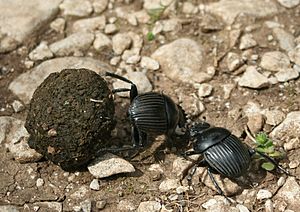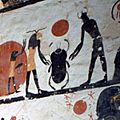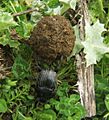Dung beetle facts for kids
Quick facts for kids Dung Beetle |
|
|---|---|
 |
|
| Scarabaeus viettei (syn. Madateuchus viettei, Scarabaeidae); picture taken in dry spiny forest close to Mangily, western Madagascar | |
| Scientific classification | |
| Kingdom: | |
| Phylum: | |
| Class: | |
| Order: | |
| Superfamily: |
Scarabaeoidea
|
Dung beetles are special beetles that mostly eat the poop (or 'dung') of mammals. They are a type of scarab beetle. There are over 5,000 different kinds of dung beetles! Some other beetles, like the 'earth-boring dung beetles' (from the Geotrupidae family), also eat dung.
Many dung beetles are called rollers because they roll dung into neat balls. They use these balls for food or as safe places for their babies. Other dung beetles are tunnelers. They bury the dung right where they find it. A third group, called dwellers, simply live inside the dung. They don't roll or bury it.
Contents
Amazing Dung Beetle Life
Dung beetles live in many different places around the world. You can find them in deserts, farms, forests, and grasslands. They don't like places that are too cold or too dry. You can find them on every continent except Antarctica.
What Dung Beetles Eat
Dung beetles mostly eat the dung from plant-eating animals (like cows) and animals that eat both plants and meat (like humans). They prefer this kind of dung over others. Sometimes, they might also eat mushrooms or rotting leaves and fruits.
There's even one special dung beetle in South America, called Deltochilum valgum, that eats millipedes! For the beetles that eat dung, they don't need to eat or drink anything else. The dung gives them all the food they need.
How They Find and Move Dung
Most dung beetles find dung using their amazing sense of smell. Some smaller kinds just wait on animals for the dung to appear!
Once a dung beetle finds dung, it will roll it into a ball. They roll in a straight line, even if there are obstacles in the way! Other dung beetles sometimes try to steal a rolled dung ball. So, beetles have to quickly roll their ball away from the dung pile to keep it safe.
Dung beetles are super strong! They can roll a dung ball that is up to 50 times their own weight. Imagine an average person pulling six double-decker buses full of people! That's how strong a male Onthophagus taurus beetle is. It can pull 1,141 times its own body weight!
In 2003, scientists found that an African dung beetle, Scarabaeus zambesianus, uses polarized moonlight to find its way. This was the first time anyone discovered an animal using polarized moonlight to navigate!
Dung Beetle Families
Dung beetles are not just one single group of insects. Eating dung is a behavior found in many different beetle families. Scientists think this behavior probably developed more than once.
Here are some of the main groups:
- Coleoptera (order): This is the big group of all beetles.
- Scarabaeoidea (superfamily): This group includes scarabs. Not all scarabs eat dung.
- Geotrupidae (family): These are the "earth-boring dung beetles."
- Scarabaeidae (family): These are scarab beetles. Again, not all of them eat dung.
- Scarabaeinae (subfamily): These are the true dung beetles.
- Aphodiinae (subfamily): These are small dung beetles. Not all of them eat dung.
- Scarabaeoidea (superfamily): This group includes scarabs. Not all scarabs eat dung.
Making a Home and Babies
Rollers roll and bury a dung ball for food or to make a special 'brooding ball' for their young. Often, a male and female beetle work together to roll the ball. Usually, the male rolls, and the female rides along or follows. Sometimes, they both roll it.
When they find a soft spot in the soil, they stop and bury the dung ball. Then, they mate underground. After mating, one or both beetles prepare the brooding ball. The female then lays her eggs inside it. Some dung beetle parents stay to protect their babies.
Dung beetles go through a complete metamorphosis. This means they change a lot as they grow. The baby beetles, called larvae or grubs, live inside the dung balls. They eat the dung around them as they grow.
A Myth About Dung Beetles
For a long time, people misunderstood how dung beetles worked together. They thought dung beetles would help each other when they faced problems. But a scientist named Jean Henri Fabre studied them very carefully. He found that the "helpers" were actually other beetles trying to steal the dung ball!
Images for kids
-
Caution sign showing the importance of dung beetles in South Africa
-
A scarab statue at the Karnak temple complex
-
A scarab, depicted on the walls of Tomb KV6 in the Valley of the Kings
See also
 In Spanish: Escarabajo pelotero para niños
In Spanish: Escarabajo pelotero para niños












